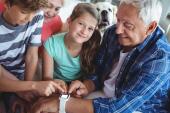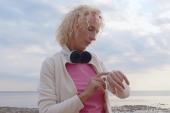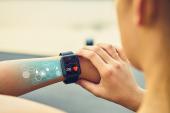Patients Most Vulnerable to CVD the Least Likely Use Wearable Devices
Less than a quarter US adults with or at risk for CVD wear a health and fitness tracker, and access to these technologies is uneven.

Less than a quarter of US adults who have CVD or are at risk of developing it say they use wearable devices like the Apple Watch and Fitbit, according to results from a new survey. Older individuals and those with lower education or income are less apt to report using these products to monitor their activity and health, patterns that researchers say raise questions about equity.
What spurred the study, published recently in JAMA Network Open, is the “societal switch towards using more emerging technologies . . . that have now become part of how we deliver routine care,” said senior author Rohan Khera, MD (Yale School of Medicine, New Haven, CT). The question moving forward, he told TCTMD, is: “Are the people who we would want to monitor with these devices actually using them, or are we going to exacerbate disparities?”
One surprise, Khera said, is that people with known risk factors for CVD were no more likely to wear a health and activity tracker than the general population. It’s uncertain whether all wearables “are clinical grade yet,” he said as a caveat, “but I would’ve expected that the health benefits that are advertised would have really drawn in people who have issues. [Instead] it seems to have drawn in people who don’t.”
Clinicians, as of yet, are uncertain about exactly what to do with wearable-provided alerts for their patients, Khera noted, citing a recent paper he co-authored showing considerable variation among physicians’ hypothetical responses to abnormal heart rhythms in an otherwise asymptomatic patient.
“While I think getting additional data points from an individual’s life outside of the health system is helpful to round out [the picture],” he said, “I don’t know if we’ve gotten to the point where these devices either have the evidence base necessary to act on [the findings] or an understanding of what they actually mean.”
But if cardiologists and other healthcare providers do decide to use patients’ wearables to track information like heart-rate trajectories, “we should be mindful [of whether] we are perpetuating some sort of disparities,” Khera emphasized. Thought must be put into how best to improve access, he said. And for people who can’t afford these devices, or don’t want to use them, there need to be alternative strategies for obtaining the information they provide.
As reported by TCTMD, data have begun to emerge in support of various roles for wearable devices, from atrial fibrillation screening and management to detection of subclinical LV dysfunction.
Age, Education, Income
Led by Lovedeep S. Dhingra, MBBS (Yale School of Medicine), Khera and colleagues turned to the Health Information National Trends Survey (HINTS) to identify 9,303 participants from 2019 to 2020. This population, representing 247.3 million US adults, had a mean age of 48.8 years, and 51% were women.
Of these participants, 9,193 agreed to take part in a survey on wearable devices. Ten percent had CVD (mean age 62.2 years; 43% women), based on their answer to a survey question asking: “Has a doctor or other health professional ever told you that you had any of the following medical conditions: A heart condition such as heart attack, angina or congestive heart failure?” Another 56% were considered to be at risk for CVD (mean age 51.4 years; 43% women), by virtue of having at least one risk factor (hypertension, diabetes, obesity, or smoking) but not overt CVD.
Translating the survey results to a national scale, an estimated 29% of the overall US adult population reported using a wearable device. By comparison, just 18% of those with CVD and 26% of those at risk for CVD—representing 3.6 million and 34.5 million US adults, respectively—said they used a wearable.
Adjusted for demographic and socioeconomic characteristics, as well as CV risk factors, there were three independent predictors that a person would be less apt to use a wearable:
- Older age (OR 0.35; 95% CI 0.26-0.48)
- Lower education level (OR 0.35; 95% CI 0.24-0.52)
- Lower household income (OR 0.42; 95% CI 0.29-0.60)
Additionally, while nearly half of device users in the overall and at-risk populations said they actually wore the products every day, just 38% of those with CVD reported daily use. A wish for privacy did not appear to be the driving force, since 83% of participants with CVD and 81% of those at risk for CVD said they favored sharing their wearable-device data with their healthcare team.
“These differences suggest that populations who stand to gain the most from the use of innovative technologies for CVD management are the least likely to use them. Moreover, the less-frequent use of wearable devices among individuals with lower socioeconomic status and educational attainment may represent a missed opportunity in expanding care in CVD for these vulnerable groups that have historically also had significantly lower access to such preventive care,” Dhingra et al conclude.
One way to expand access to wearables would be through insurance coverage, they suggest, but first there must be “rigorous evidence that unequivocally establishes their role in disease management.”
Then, there’s the patient perspective, Khera pointed out.
Do patients in fact think these devices are okay to use in healthcare decision-making? That question is something their current research is looking into, he said. Whatever they find could help clarify why certain groups, such as older adults, are less likely to use wearables.
Caitlin E. Cox is News Editor of TCTMD and Associate Director, Editorial Content at the Cardiovascular Research Foundation. She produces the…
Read Full BioSources
Dhingra LS, Aminorroaya A, Oikonomou EK, et al. Use of wearable devices in individuals with or at risk for cardiovascular disease in the US, 2019 to 2020. JAMA Netw Open. 2023;6(6):e2316634.
Disclosures
- Dhingra reports no relevant conflicts of interest.
- Khera reports receiving grant funding from the National Heart, Lung, and Blood Institute (NHLBI) and the Doris Duke Charitable Foundation during the conduct of the study; personal fees from Evidence2Health, for which he is a cofounder; and grant funding from Bristol Myers Squibb and Novo Nordisk outside the submitted work. He has patents pending for Provisional Applications No. 63/177,117 (Methods for neighborhood phenomapping for clinical trials), No. 63/346,610 (Articles and methods for format independent detection of hidden cardiovascular disease from printed electrocardiographic images using deep learning), and No. 63/428,569 (Articles and methods for detection of hidden cardiovascular disease from portable electrocardiographic signal data using deep learning).





Comments